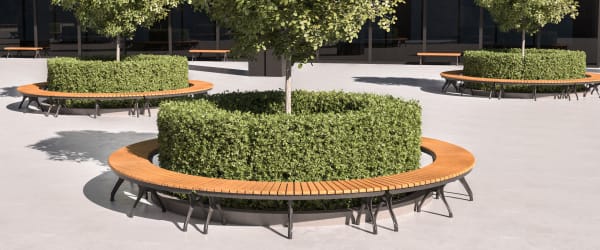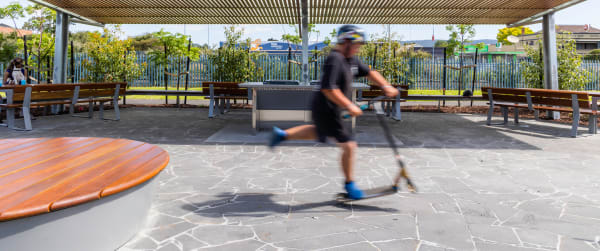Public spaces play a vital role in fostering well-being, mindfulness, and social connection. As cities grow denser and life becomes more fast-paced, the need for thoughtfully designed urban environments has never been greater. More than just places to pass through, these spaces serve as essential retreats where people can relax, interact, and reconnect with nature.
One key element in shaping these experiences is modular urban furniture. More than just static benches and tables, modular furniture systems are designed to complement different environments through thoughtful customization. The versatility of these systems reshapes how people interact with their surroundings—benches become meeting spots, tables double as remote working hubs, and platforms shift from seating to performance stages. Every element is crafted to enhance engagement and sustainability, foster inclusivity and be responsive to the changing needs of today’s urban life.
Examples of flexible solutions include:
Customizable modular furniture: options like modular seating and tables enable easy reconfiguration to suit various needs, from large community events to quiet relaxation zones.
Curved benches that wrap around natural elements like trees, ensuring the seating harmonizes with its surroundings.
Projects like Moe Skate Park highlight how modular furniture can support dynamic spaces that balance aesthetics with usability, creating environments that cater to diverse activities and users. Connect Circle Benches, in a mix of sizes, provide comfortable, durable seating that seamlessly adapts—from a casual social spot to an impromptu skate feature—enhancing both the functionality and character of the space.
Flexibility empowers urban designers to optimize space while fostering interaction and engagement.
1. Multi-functional designs
As urban areas grow and public space becomes increasingly limited, maximizing efficiency without sacrificing comfort or usability is essential to meeting the rising demand for functional and inviting public areas. Modular furniture addresses this need by integrating multi-functional elements into a cohesive system that adapts to evolving community needs. With customizable configurations, seating areas can be tailored to fit the unique layout and character of any space, ensuring flexibility regardless of size or constraints.
Examples of multi-functional designs:
Benches with integrated planters create green spaces while providing comfortable seating, offering a place to unwind, recharge, and benefit from the proven well-being boosts of time spent in nature.
Low benches that double as picnic settings and seating provide versatile, space-efficient solutions for both compact and expansive public areas, ensuring functionality without compromising comfort.
These designs not only optimize space but also add aesthetic value, ensuring public areas remain welcoming and practical.
2. Longevity and adaptability in public space design
For public spaces to remain functional and engaging over time, urban furniture must be designed with long-term usability, maintenance, and adaptability in mind. Modular furniture not only enhances immediate flexibility but also ensures that public spaces can evolve with changing community needs without requiring costly replacements or extensive redesigns.
Key factors that contribute to longevity and adaptability include:
Interchangeable components – Modular designs allow damaged or outdated parts to be replaced individually, reducing waste and maintenance costs.
Scalable configurations – Public spaces can expand or reconfigure layouts as foot traffic, activities, or seasonal needs change.
Weather-resistant materials – Durable, low-maintenance materials, including hardwood and stainless steel, ensure that furniture withstands heavy use and harsh climates, minimizing the need for frequent repairs.
Timeless aesthetics – Neutral, adaptable designs complement evolving urban landscapes and stay relevant for years to come.
.
The ANZAC Park Somerset project showcases this principle by using modular furniture solutions that blend durability with flexibility, ensuring that the play space remains relevant and user-friendly for years to come. A standout element of the playground is the Avenue Curved Bench, carefully selected for its accessibility-promoting design and long-lasting durability. Its curved, modular form enhances inclusivity, allowing for easy access and interaction while also creating dynamic seating arrangements that can adapt to different uses.
3. Furniture that fosters community connection
Public spaces thrive when they bring people together while also offering moments of retreat. Curved modular furniture enhances this balance, with configurations that can invite social interaction or create private, reflective spaces depending on the arrangement.
Key features that enhance inclusivity include:
Adjustable configurations – Modular pieces seamlessly fit together in unique ways, adapting to different spaces and shaping how people interact with their surroundings.
Curved modular seating – Flowing forms soften rigid spaces, shaping movement and interaction naturally.
Versatile placement – Pieces can be reconfigured to suit plazas, walkways, or intimate courtyards, telling different stories of a space.
Accessible designs – Wheelchair-accessible seating and adjustable-height elements ensure inclusivity for all users.
By prioritizing flexibility and accessibility, modular urban furniture transforms public spaces into dynamic, people-focused environments that evolve with their communities.
4. Urban furniture trends shaping the future
The future of urban furniture lies in innovation. Emerging trends are shaping how designers approach public space solutions, ensuring they remain relevant and impactful.
Key trends include:
Smart urban furniture – The integration of technology, such as solar-powered charging stations, and integrated lighting as seen in the Connect collection, enhances both usability and safety in public spaces.
Climate resilience – Modular designs must withstand harsh environmental conditions, with materials like hardwood treated with a UV-resistant oil finish and powder-coated, pre-galvanized steel frames ensuring longevity and durability.
Biophilic design – Incorporating planters into furniture designs brings much-needed greenery into urban spaces where it can otherwise be limited, fostering a stronger connection to nature while enhancing aesthetics and air quality.
botton+gardiner continues to prioritize these areas, crafting innovative solutions that merge user-centric design, smart planning, and durable materials to create urban spaces that are both functional and built for the future.
Modular urban furniture is more than a trend—it’s a transformative solution for the adaptable, sustainable, and inviting public spaces of tomorrow. By combining flexibility with eco-friendly materials, these innovations are reshaping urban environments into hubs of connection, creativity, and sustainability.






